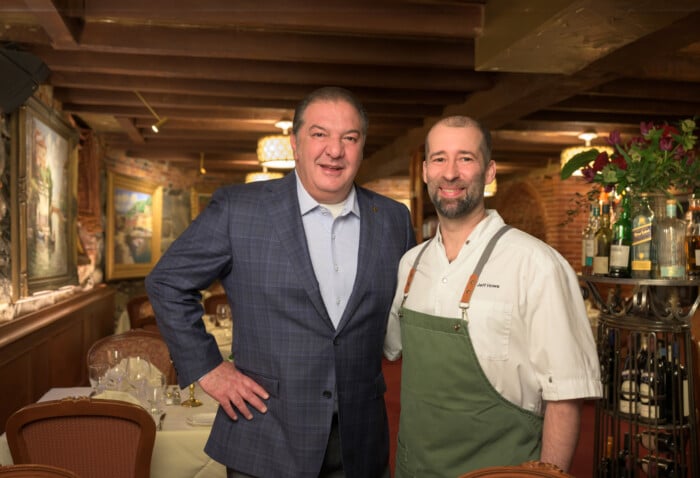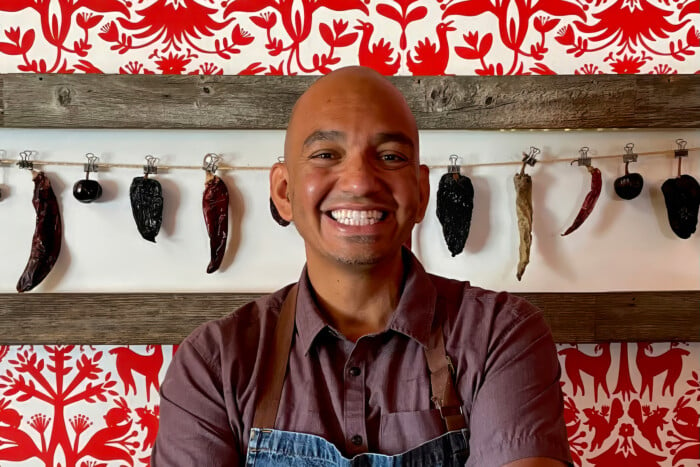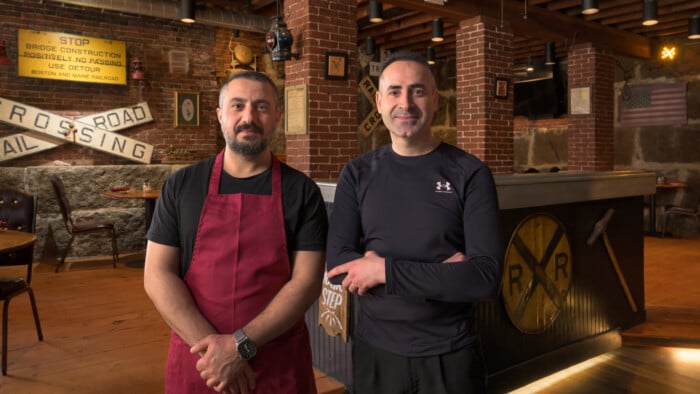Harvest of Hope With Josh Andrews Owner of New Hope Farm
A seasoned farmer puts down new roots in Lee

Left to right: Bria Loureiro, part-time farmer; Josh Andrews; Miranda Gagnon, market and flower manager
New Hope Farm is the dream project of Josh Andrews, owner and chief farmer of this pristine three-acre vegetable, herb and flower farm in Lee. Working with a small staff, he provides the Seacoast area with a harvest of vegetables, including tomatoes, mixed salad greens, potatoes, carrots, peas, Chinese broccoli, winter squash, radishes, kale and onions.
Growing up in Chelmsford, Massachusetts, Andrews’ path to farming brought him from working in a restaurant to pursing an MBA in corporate sustainability. Now in his fifth year of farming — beginning in North Hampton and transitioning in March of 2024 to leasing land in Lee, as owner of New Hope Farm — Andrews’ mission is to respect the land and do his part to provide customers with locally grown, organically produced vegetables. Besides a farm stand where customers can pick up orders, he supplies vegetables to area restaurants and farmers markets and offers a CSA boxed share program.
Mary Ann Esposito [MAE]: What got you started in farming?
Josh Andrews [JA]: I got a late start in the ag world; I didn’t start farming until I was 26. Growing up in the suburbs, farming seemed more of an abstract concept than a potential career. Field trips and petting zoos and apple picking, yes, but nothing more. I can’t say there was a defining moment that got me into farming, but while working in a restaurant kitchen and pursuing an MBA, where I was learning about corporate social responsibility and the concepts of sustainable businesses and the triple bottom line — yadda, yadda, yadda — and certainly being aware of climate change in general, farming became a sort of beacon of opportunity to learn more about the food I was chopping on the prep table, to apply my business education, and to also have a positive impact on the environment and local food economy. It was, and is, challenging. It’s a leap of faith and a complete lifestyle uprooting, but I’m glad I did it, I’m glad I do it and I won’t look back.
MAE: Why the name: New Hope Farm?
JA: In early spring, after those long winters, the garden’s hopes and dreams begin to take shape. Above all else, I think we chose the name because of its poetic sentiment. But also critical in the farm-naming process was (and is) the meme potential. Episode IV of the original Star Wars was called “A New Hope,” and at the beginning a young and eager Luke Skywalker joins the rebel cause — and, yes, we all know that long story. In Luke and his path to becoming a Jedi, we see many parallels to our journey of being farmers. Also, this is a new plot of land for us. We’ve never farmed here before. This garden was born in 2024, and so it’s a New Hope Farm.
MAE: Besides the weather, what other challenges does gardening present?
JA: How much time do you have? I joke, but macroeconomic challenges are ever present and continue to strain our operating budget. As small-scale farmers, we are not immune to supply chain woes, diesel and gas price volatility, cost of materials and equipment and infrastructure, inflation and shrinkflation, the absurd housing market, the cost of land — these are some of the biggest challenges.
Volatile weather — in my short, 10-year farming career so far, we’ve experienced some of the worst droughts on record and the wettest years on record, late frosts and early frosts. These unpredictable and volatile weather patterns can create major challenges in the crop plan.
If you’ve ever tried to grow food, then I’m sure you’ve dealt with one or all of these pests: deer, voles, mice, woodchucks, rabbits, Colorado potato beetles, cucumber beetles, tomato hornworms, flea beetles, cabbage worms … the list goes on.
 MAE: Approximately how many kinds of veggies do you grow?
MAE: Approximately how many kinds of veggies do you grow?
JA: Diversity is one of our main focuses and key strengths. We grow over 100 different varieties of fruits, vegetables, herbs and cut flowers.
MAE: What is the biggest reward you get from growing vegetables?
JA: Getting the right job done at the right time on the right day. Stringing lots of those together is very rewarding! It’s also the people, and the relationships we’ve built along the way. From our little crew and our volunteers and friends and past work-share members to farm visitors and all our beautiful farmers market customers and the amazing and supportive chefs that we deliver to, it’s a thriving and amazing community!
MAE: What is a CSA?
JA: CSA stands for community-supported agriculture. It’s a way for individuals and families to support their local farms directly. In years past, we’ve used a subscription-based model where our customers would join in early spring, pay upfront for their weekly share, and come once a week to pick up their bounty. It’s a win-win. The community gets high-quality and fresh vegetables, and the farmer has cash flow at a particularly lean time of year.
MAE: What do you envision as the future of farming for independent entrepreneurs like you?
JA: It will always be challenging, but that is part of its allure. I am optimistic about the future of organic/regenerative farming. I see a shift in market sentiment and a return to the land. I see a future with more small-scale and highly diverse farms. I see more people growing their own gardens and raising their own livestock. I see the rebel cause always coming out on top.
Harvest Vegetable Casserole
Serves 8
This rich and filling casserole makes the most of what is left at harvest time, with a blanket of eggs, cheese and cream. Serve it as a main course or as a side for roasted chicken, grilled fish or beef.
2 cups 1-inch broccoli florets
2 cups 1-inch cauliflower florets
2 tablespoons extra-virgin olive oil
1 large onion, diced
1 clove garlic, minced
2 cups halved cherry tomatoes
Salt and freshly ground black pepper to taste
4 large eggs
1 cup heavy cream
¼ cup fresh thyme leaves
3 cups grated Swiss cheese
Paprika, for sprinkling
Directions
- Preheat the oven to 350° Fahrenheit.
- Fill a large sauté pan with water and bring to a boil. Add the broccoli and cauliflower florets, and cook for 3 minutes. Drain, empty into a bowl and set aside.
- Heat the olive oil in the same sauté pan over medium heat. Add the onion and cook until it softens, about 5 minutes. Add the garlic and cook for a couple of minutes. Return the broccoli and cauliflower to the pan and stir with the onion mixture. Add the tomatoes and cook for a couple of minutes, until the tomatoes begin to exude their juice. Season with salt and pepper.
- Transfer the mixture to a 9- or 10-inch casserole dish.
- In a medium bowl, whisk together the eggs, cream, thyme, salt and pepper. Pour the mixture over the vegetables. Distribute the cheese evenly over the top. Sprinkle paprika over the cheese.
- Bake for 30 to 35 minutes, or until the cheese is melted. Scoop from the dish to serve.
Stuffed Tomatoes with Wild Rice
Serves 4
 A great way to use up those end-of-season tomatoes and welcome fall is to stuff and bake them with a rice and herb filling.
A great way to use up those end-of-season tomatoes and welcome fall is to stuff and bake them with a rice and herb filling.
2 tablespoons olive oil, plus more for greasing pan
4 large beefsteak tomatoes
1½ cups chicken broth
¾ cup wild rice
¼ cup minced onion
2 tablespoons minced fresh
flat-leaf parsley
2 tablespoons minced fresh tarragon
2 tablespoons minced fresh basil
Salt and freshly ground black pepper to taste
1 cup shredded cheddar or Swiss cheese
Directions
- Preheat the oven to 350° Fahrenheit.
- Brush a medium casserole dish with olive oil.
- Cut off the tomato tops and set aside. Hollow out the pulp with a small spoon, leaving about a ¼-inch-thick wall. Chop the pulp and put it in a colander set over a bowl to collect the tomato juices. Turn the hollowed-out tomatoes upside down on paper towels and allow them to drain for 5 minutes.
- Pour the broth into a medium saucepan, add the drained tomato juice, and bring to boil. Stir in the rice, lower the heat, cover and cook until the rice has absorbed the liquid and is tender, about 20 minutes.
- Heat the olive oil in a sauté pan over low heat. Add the onion and cook over low heat until it wilts. Add the rice, chopped tomatoes, parsley, tarragon, basil, salt and pepper, and cook for 4 minutes.
- Turn the tomatoes right side up and lightly salt the cavities. Fill each tomato with the rice mixture and place them in the prepared casserole dish. Sprinkle the cheese evenly over the top of each tomato.
- Bake for 30 to 35 minutes, or until the tomatoes have started to shrivel and the cheese has melted. Replace the tomato tops and bake an additional 5 minutes. Serve hot with some of the pan juices.










